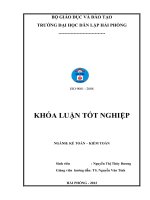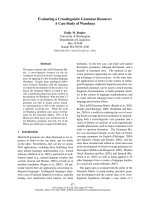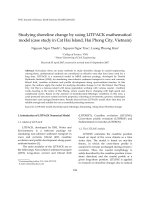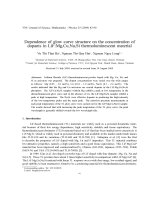Báo cáo " Studying shoreline change by using LITPACK mathematical model (case study in Cat Hai Island, Hai Phong City, Vietnam) " ppt
Bạn đang xem bản rút gọn của tài liệu. Xem và tải ngay bản đầy đủ của tài liệu tại đây (374.22 KB, 9 trang )
VNUJournalofScience,EarthSciences23(2007)244‐252
244
Studyingsho reline changebyusingLIT PACKmathematical
model(casestudyinCat HaiIsland,HaiPho ngCity,Vietnam)
NguyenNgocThach
1,
*,NguyenNgocTruc
1
,LuongPhuongHau
2
1
CollegeofScience,VNU
2
HanoiUniversityofCivilEngineering
Received05April2007;receivedinrevisedform10September2007
Abstract. Nowadays, there are many methods to study shoreline change in coastal engineering.
Among them, mathematical methods are considered as effective ones that have been used for a
long time. LITPACK is a numerical model in MIKE software package, developed
by Danish
Hydraulic Institute (DHI), for simulating non‐cohesive sediment transport in wave and currents,
littoral drift, coastline evolution and profile development along quasi‐uniform beaches. In this
paper, the authors apply the model for studying shoreline change in Cat Hai Island, Hai Phong
City. Cat Hai is a famous island with dense population working with various coastal‐tradition
works locating at the centre of Hai Phong, where coastal line is changing with high speed and
complicated cycles. Based on the analysis of hydrodynamic‐lithologic conditions in this area, a
coastprotectedstructuresystemhasbeenproposed,consistingofrevetments,groynes,
submerged
breakwatersandemerged breakwaters.Results derivedfromLITPACKmodel showthat theyare
reliableenoughandsuitableforuseasremedialprotectingmeasures.
Keywords:LITPACKmodel;Hydrodynamic‐lithologic;Simulating,Alongtime;Shorelinechange.
1.IntroductionofLITPACKNumericalModel
*
1.1.ModelofLITPACK
LITPACK, developed by DHI, Water and
Environment, is a software package for
simulating non‐cohesive sediment transport in
wave and currents, littoral drift, coastline
evolutionandprofiledevelopmentalongquasi‐
uniformbeaches[1].
The main modules of the LITPACK are as
thefollowings:Non‐cohesivesediment
transport
(LIST); Long‐shore current and littoral drift
_______
*Correspondingauthor.Tel.:84‐4‐5571178.
E‐mail:
(LITDRIFT); Coastline evolution (LITLINE);
Cross‐shore profile evolution (LITPROF) and
Sedimentationintrenches(LITTREN).
1.2.TheLITLINEmodule
LITLINE calculates the coastline position
based on input of the wave climate as a time
series data. The model is based on one‐line
theory, in which the cross‐shore profile is
assumed
toremainunchangedduringerosion/
accretion. Thus, the coastal morphology is
solelydescribedbythecoastlineposition(cross‐
shore direction) and the coastal profile at a
given long‐shore position. LITLINE is applied
inresearchonshorelinechangesduetonatural
NguyenNgocThachetal./VNUJournalofScien ce, EarthSciences23(2007)244‐252
245
conditions,protectedconstructionsandresearch
on shoreline recovering measures by artificial
beachnourishment.
TheapplicationofLITLINEisunderpinned
by the equation of the continuity for sediment
volumesQ(x)[1]:
()
()
()
()
()
xxh
xQ
x
xQ
xht
xy
act
sou
act
c
∆
+
∂
∂
−=
∂
∂
1
inwhich,y
c
(x)isthecoastlineposition;tistime;
Q(x) shows the alongshore sediment transport
expressed in volume; x is long‐shore position;
h
act
(x)–heightoftheactivecross‐shoreprofiles;
x∆ is long‐shore discretization step; Q
sou
(x)
source/sinktermexpressedinvolume.
h
act
(x) and Q
sou
(x) are calculated based on
user specifications,inwhichQ(x) derivedfrom
the table of sediment transport rate in surf
zone. From an initial coastline position y
init
(x),
the evolution in time is determined by solving
theaboveequation.
Solution
The continuity equation for sediment
volumes is solved using an implicit Crank‐
Nicholson scheme, giving the development of
the coastline position in time. It can be solved
asfollows:
Thegeneraltransportedtrendinlong‐shore
direction
sketched in Fig. 1 and 2, in which Q
i
denotes the transport rate between x
i
and x
i+1
,
while dQ
i
denotes the change in the transport
rate with respect to change in coastline
orientation (for values of
θ
close to the local
orientation
0
θ
).
),()(
0
θ
θ
x
d
dQ
xdQ =
(2)
Fig.1.Long‐shorediscretization.
Fig.2.Definitionofbaselineorientation.
Asubscripttdenotes(known)valuesofthe
presenttimestep,whilet+1denotes(unknown)
values of the next time step. Transport rates
corresponding to time step t+1 are estimated
through:
BasedonaCrank‐Nicholsonscheme[5],the
continuityequationinEq.1canbewrittenas:
itiitiitii
dycybya =++
++++− 1,11,1,1
(3)
where:
(
)
()
()
itititiitiitiii
iii
ii
ii
QSQQxycybyad
ca
t
hx
b
dQc
dQa
−−∆−++=
−−
∆
∆
=
−=
−
=
−+−
−
,1,,1,,1
2
1
.
1
1
α
α
iiii
dcba ,,,
canbefoundforthepresenttime
step,andwithtwoboundaries(Qandcoord in a t e
ofeachpointatt-1),thesystemofequationfor
alllong‐shorepositionscanbesolvedbyGauss‐
elimination.
Theparameter
α
isCrank‐Nicholsonfactor;
itdetermineshowimplicitofthesolutionscheme
is: a value of 0 gives a fully implicit solution,
andavalueof1givesafullyexplicitsolution.
Input data for the module comprise
topographyconditionsincludingpositionofthe
coastline,theduneproperties,offshorecontours
and the appearance of the cross‐shore profile
alongthebeach,theroughnesscoefficientofthe
bed.Theseparametersarespecifiedbasingona
coordinate system in which x‐axis is baseline
quasi‐parallel to the initial coastline, and y is
perpendiculartoxandorientedsea(Fig.2).
Other input
data for LITINE are: sediment
(1)
NguyenNgocThachetal./VNUJournalofScien ce, EarthSciences23(2007)244‐252
246
characteristics (mean diameter of sediment d
50
,
geometrical spreading); hydrologic conditions,
(that is medium sea level consisting of storm
surge and tide); wave conditions (wave field
depicted into 2D wave table, consisting of
parameterofwave height,wavedirectionsand
periods), this table is edited to LINLINE input
data through sub‐program of LINCONV.
Current conditions: beside
the wave‐induced
current automatically calculated, other factors
arealsomentionedanddirectlyenteredintothe
program with currents parameters such as
speed, direction and other parameters of
structureconditions(number,position,apparent
dimensionsandfactorsforactivedimensionsof
coastal structures such as: groynes, jetties,
revetments,breakwater).Resultsare
theoutput
dataofthemodelshowningraphicandtabular
forms,consistingof:
‐Coastlinepositionintimeseries(m);
‐Depthofthetopographicbed(m);
‐Sedimenttransportrate(m
3
/day);
‐Accumulationofsedimenttransport rate(m
3
);
‐Sedimenttransportrateunit(m
3
/m).
2. LITPACK application for Cat Hai Island,
HaiPhongCity
2.1.Locationofthestudyarea
LocatedbetweenCatBa IslandandDoSon
Peninsula with coordinates 20
0
47ʹ20ʺN‐
20
0
50ʹ12ʺN and 106
0
40ʹ36ʺE‐106
0
54ʹ05ʺE, Cat
Haiisanisland witharea ofmore than25km
2
and is about 24 km far from Hai Phong center
in the east‐southeast direction. The island is
located in Bach Dang Estuary.It has boundary
with Quang Ninh Province in the north, to be
separated with Phu Long‐Cat Ba Island by
Huyen Inlet 1.5 km of width in
the east. The
islandborderswithGulfofTonkininthesouth
andHaiPhongshippingchannelinthewest.
2.2.ThecurrentstatusofCatHaishoreline
Cat Hai Island is a place where erosion is
happening with highest speed comparingwith
other places of Hai Phong coastal line.
At
present,theislandhas been strongly erodedso
that the coastal line was pushed back at high
speed from 5 to 6 meters per year in average.
Especially at VanChan, erosion speed reached
25 meters per year. In contrast, sedimentation
occurredatHoangChau‐BenGoisectionfrom
1938
to 1991, but that area has eroded again.
Duetotheerosionriskattheplace,creatingaplan
fordamandother coastprotectedconstruction
systemisthestudy’spurpose.Erosionprocessin
recentyearscanbeobservedclearlybycomparing
Landsatimagestakenin1999,2002and2003.
Accordingtodynamicsh apeandchar acteristic
oftheLITINEmodel,thecasestudyshorelineis
6200 m long (from Hoang Chau to Got), it is
dividedinto5segments(Fig.3):
‐ Segment of Center Island (Gia Loc‐Cai
Vo segment) is 4325 m long, characterized by
surfaceerodingandlowering
process,whichis
caused by action of South and South‐East
breaking wave in the South‐West monsoon
leadingtoerosionandpushbackcoastline.
‐ The second segment (Hoang Chau
segment), 500 m, is characterized by erosion
processbecauseoflong‐shoretidalcurrents.
‐Thethirdsegment(shorelineofGot
‐Hang
Day inlet), 425 m, is characterized by erosion
processbecauseoftidalcurrentimpact.
‐ The fourth segment (shoreline of Nam
Trieu Inlet), about 400m long, is characterized
byverylighterosion.Tidalandwind‐generated
currentscausesedimentationoccasionally.
‐ Thefifth segment,LachHuyenInletwith
350m
long,ischaracteri zed byslighterosionand
sediment deposition. In this area tidal currents
aredominated. Thesubmergedside of CatHai
Islandiscalculatedforaunderwatersandbar,
whichelongatesabout4000mlongcoastlineof
average100mwide,andgentleslope.
2.3.Orientationcoastprotectedconstruction
This paper does not mention detailed
description in design and structure of coast
protected construction system. We focused on
NguyenNgocThachetal./VNUJournalofScien ce, EarthSciences23(2007)244‐252
247
consideration of natural and social conditions,
especially in lithology and hydrology dynamic
conditions in order to design a suitable and
effective protecting construction system. Then,
weusednumericalLITPACKmodeltoevaluate
itstechnologicaleffectivenessasacasestudy.
Protectionobjectives
Based on shoreline changes, the needs of
socio‐economic
developmentandCatHaiIsland’s
masterplan,designingandarrangingprotected
constructions in Cat Hai coastline should
A
A
off-shore depth contours
coastline
dune front
y dune
y
i x
Baseline
X
A - A
N
e
a
r
s
h
o
r
e
d
e
p
t
h
c
o
n
t
o
u
r
s
h dune
Dact
WL
NWL
Baseline
D lim
y
∆y
y dune
h beach
Note:
+
B
θ
:
clockwiseanglewith
normaltobaselineandthe
northdirection,;
+y
dune
:duneposition;
+ h
beach
: height of the active
beach;
+h
dune
:heightofdune;
+ Offshore con tours: contours of
offshoredepth;
+D
act
:activedepth.
Fig.3.Definitionofcomponentsincoastlinedescription.
Got-Hang Day
segment
Transition
se
g
ment
Hoa Quang – Gia
Loc segment
Gia Loc–Cai Vo segment
Van Phong
Hoang Chau
se
g
ment
GULF OF TONKIN
CAT HAI ISLAND
Fig.4.CurrentstatusofthecasestudyontheSPOT4image.
NguyenNgocThachetal./VNUJournalofScien ce, EarthSciences23(2007)244‐252
248
achieve following functions: (1) Prevent tidal
flood and sea water passing dyke into
residentialarea; (2)Prevent carryingsediments
of alongshore current outof conservationarea;
(3) Minimize wave height before breaking and
carrying sand out of coastal zone; (4) Build an
aestheticandstableshoreline.Additionally,itis
necessary
to build a street surrounding island
to meet the transport and economic
developmentneedsofisland’sresidents[2].
Generalinstructionsforprotectingconstructions
inthestudyarea
Solutions such as mangrove growing are
not applicable because of erosion conditions
and environmental conditions are unsuitable.
Artificial beach nourishment also cannot be
used
because waves and currents will carry
those materials to shipping channel of Hai
Phong Port and make siltation. Besides,
buildinggroyneswillnotbeeffectiveifmissing
breakwaterbecausegroynespreventonlysand.
They do not have effect on reduction of wave
dynamic; they can even raise the height of
waves. However, one of the most important
objectivesis theneed toreduce wavedynamic.
According to the regulations for designing sea
dyke, it is not supposed to build too high. In
this case, breakwater is the good solution to
restricttheheightofdyke.
Havingahigh andstabledyke
systemthat
can prevent seawater surge in high tide is
necessarytoavoidsaltpenetrate.Totallengthof
seadykepartsis6200m.
Main factor causing erosion along Cat Hai
shoreline is the south and southeast storm
wind‐induced wave, thus the privileged
requirementofconstructionreinforcin gmeasures
is
to build the breakwater parallel with the
shoreline and perpendicular to wave
propagation.Its responsibility is cutting waves
tominimizethewaveheightandenergybefore
breaking. It is estimated that breakwater can
minimize approximately 50% of wave height.
During the second
and the sixthstormin 2005,
strong waves passed over, eroded the top and
insideofdyke,destroyedoutsidestructureand
almost of construction system because of
inexistenceofthebreakwaters.
In order to protect coastal zone and avoid
substance to be carried toward to both sides of
island that causes
shallow surface, it is
necessary to build sand‐prevented construction
systems perpendicular to shoreline, which are
groynes.Constructionsinthisareahavetofulfill
dimensionandstructurestabilityrequirements.
We should not use the natural materials with
unsuitable size or loss weight structures. It
requires the resistant structures to confront
waveattackanddyke,revetmentbasescour.
2.4.Masterarrangementofconstructionsystem
About constructionof the system,it can be
clearedwithsomemaindescriptionasfollows:
‐Dykesystem:developandbuildsomenew
bare dyke segme n ts based on present dyke
segments to makeacomplete dykesystem and
touseasastreetaroundtheisland.
‐ Breakwater system is built with curved
shape. Its location and size are guided by
government with detail: the longest distance
betweenthebreakwateranddykeis160mlong
and height is 1 to 1.5 times higher than the
wavelength. The breakwater
length is 1.5 to 3
times the distance between the dyke and
breakwater, as a result, the length of designed
breakwater is 200 m. Submerged breakwater is
locatedalternatelywithemergedbreakwaterto
reduce the height of wave attack, prevent
erosion dyke as well as to create advantage
conditionsfortransportation
sedimentsbetween
insideandoutsideofconservationarea.
‐ Groynes combining dyke and breakwater
areresponsiblefor preventingsand.Thedistance
among groynes is 2 to 3 times longer than the
lengthofeachgroyne.
‐ The structures connect breakwater with
revetment combines two tips of dyke (from T
shaped‐breakwater
construction to dyke) into
NguyenNgocThachetal./VNUJournalofScien ce, EarthSciences23(2007)244‐252
249
anadvantage,stablelinesystem.
2.5. Calculate changes of shoreline after having
prote cte dcons truc tions byusin gLITPACKmodel
After arranging shoreline protected
constructionssystem,modelingstudyshoreline
is implemented by using LITPACK model to
simulate, calculate and forecast the change
orientation.Input dataconsists ofwaveheight,
wind speed, sea
water level, sediments and
otherinputparameters.
Topographical data: Location of shoreline,
shape of cross‐shore profiles, direction of
contours in deep water area according to
topographicaldatain2002with5820mlongof
island shoreline; angle between its normal and
northis173
0
.
Wave data:Bas ed on the frequency of wave
heightandwaveperiod(Table1).
Other parameters: the values of other
parametersare[5]:
‐Roughness:0.012;
‐Geometricalspread ing(
16/84 dd
):0.748;
‐Meangraindiameter d
50
:0.1mm;
‐Fallvelocity:0.06m/s;
‐Timeofcalculation:12months.
Besides, it is necessary to put other data
when having protected constructions such as
types of construction (including revetments,
groynes, emerged breakwaters and submerged
breakwaters); number of construction types
(revetments, groynes, emerged breakwaters and
T‐shapestruct u r es,submergedbreakwaters,and
jetties); coordinate depicting location of each
constructiontypesuchasapparentlength,useful
length,distancefromstructuretoshoreline,
2.6.Modelingthecalculatedarea
The mathematical model isappliedintoan
area of5820 min length(from HoangChau to
Got) and 1200 m in width (from shoreline to
sea)withgridstepof10mparallel(583points)
and 10 m perpendicular to the shoreline (120
points). Time of simulation is 12 months, from
Januaryto Decemberof a year, and the step is
60 hours. Input data for the model consist of
number calculated cross‐shore profile, location
of points, roughness of seabed, diameter of
seabedsubstances,geometricalspreading.
2.7.Procedureofcalculation
The calculation process has been done in
thefollowingsteps:
‐Inputtopographicalparametersandother
related conditions (shoreline, cross‐shore
profiles, ).
‐ Input annually monitored table of wave
frequency and convert it into input wave
data
byusingLITCONVmodule[3].
‐ Convert input sediment data by using
LITTABLmodule.
Table1.Waveheightandwaveperiodduringyear[4].
Month 1 2 3 4 5 6 7 8 9 10 11 12
Direction S E‐SE E S‐SE S‐SE SE S E E E S E‐NE
Waveheight(m)
0.0‐1.07.7 7.7
1.0‐2.0
2.0‐3.0 9.1 7.6 7.5 9.36.8 6.7 7.1
3.0‐4.09.3
4.0‐5.08.2
Wavesperiod
T(s)
5.0‐6.011
NguyenNgocThachetal./VNUJournalofScien ce, EarthSciences23(2007)244‐252
250
Fig.5.Illustrationofgraphicandtabularresults.
CCross Crosssection of
Bathymetry [m]
09/10/05 23:00:06:000
0 100 200 300 400 500 600 700 800 900 1000 1100 1200
-2.0
-1.0
0.0
1.0
2.0
3.0
4.0
Mat cat phia bac vung Cai Vo (xom Hau)
Cross section at the North of Cai Vo
Bathymetry [m]
09/10/05 01:59:19:000
0 100 200 300 400 500 600 700 800 900 1000 1100 1200
-2.0
-1.0
0.0
1.0
2.0
3.0
4.0
Mat cat phia Bac mui Hoang Chau 1
Cross section at the North of Hoang Chau pole
Bathymetry [m]
09/10/05 02:22:52:000
0 100 200 300 400 500 600 700 800 900 1000 1100 1200
-4.0
-2.0
0.0
2.0
4.0
Mat cat Ben Got - Chuong Hang Day
Cross section at the Ben Got- Chuong Hang Day
Bathymetry [m]
09/10/05 02:12:52:000
0 100 200 300 400 500 600 700 800 900 1000 1100 1200
-1.0
0.0
1.0
2.0
3.0
4.0
Mat cat phia Nam vung Cai Vo
Cross section at the south of Cai Vo pole
NguyenNgocThachetal./VNUJournalofScien ce, EarthSciences23(2007)244‐252
251
‐RunLITPACKandenterotherparameters.
‐ Export results into graphs and animated
images by PLOT COMPOSER in MIKE Zero
package.
2.8.Resultsanddiscussion
After entering and calibrating input data,
LITPACKwillautomaticallycalculateandprint
outtheresults.Productsaresimulatedbydetail
numerical tables and graph due
to changing
time. With tabular results, one can observe
directly on numerical table and shoreline
graph,andtheneasilyrealizethattheshoreline
changeprocesswill occurmore positivelythan
natural change process. Depositing sediments
occurs strongly at the root of groynes and at
segments without groynes (Fig. 5). Graphic
results
(activelength ofgroynes)are calculated
fromrevetment tobreakwaterand thedistance
between baseline and breakwater is called
apparentlength.
The result shows that: after 6 months,
deposition sediments occur at the bottom of
groynes, especially in Got, Hoa Quang, Hoang
Chau groynes. However, erosion occurs at the
gap
of western Hoang Chau and the outside
areaofdyke.
For longer time, after 12 months, shoreline
will become more stable and deposition will
occur at most of coastal zone, strongest at
bottom of Hoa Quang, Van Phong, Hoang
Chau groynes. In other sides, erosion process
will continuously happen at
segments among
Western Hoang Chau groynes (this area is out
of dyke and apart from old alluvial) and stop
when reaching revetment and beingalternated
byastronglyalluviumdevelopment.
Accordingtotheseresults,HoangChauhas
themost stabledepositedrateof27 moverthe
area; other segments slowly
widens to the sea
from2to15m.Particular lyinHoaQuanggroynes,
depositedrateis47mperyearbutthisalluvial
segmentisnotlargeandstable.
In planning, evolution of the dynamic
process can be illustrated that: after arranging
construction,changesofCatHaiIslandshoreline
are quite reasonable with lithology‐dynamic
rule of this area. In fact, waves erode coastal
zone and sediments are carried by long‐shore
currentstoNamTrieuinthewest,whichcause
siltation of Hai Phong shipping channel.
Sediment is carried to Got and Huyen Inlet in
the north. After arranging
sand and wave‐
preventedconstruction,sedimentcarriedtothe
west is trapped at Hoang Chau groynes with
stablecumulativerateatthehighestrateof27m
per year. Meanwhile, stable alluvium rate at
otherareasislower;thelowestrateinGiaLoc‐
Cai Vo is only from 2
to 5 m per year where
sedimentcarriedfromthenorthintoHuyenInlet
istrappedat groynesin HoaQuangand Gotareas.
3.Conclusions
Arrangementshoreline protected constructi on
system in Cat Hai is mainly based on the
analysisofhydrodynamic‐lithologicconditions,
meteorological,economic,socialconditionsand
masterplan
oftheisland.
The LITPACK model can be successfully
applied for simulating, calculating and
forecasting orientation of coastal line changes
duetoerosionandsedimentationprocess.
According to the simulated and calculated
results, the selected protected construction
system, which includes revetments, T‐shape
sand prevented constructions, emerged and
submerged breakwaters,
is the most suitable
and reasonable counter measures for Cat Hai
shorelinestabilization.
References
[1] Danish Hydraulic Institute (DHI), An integrated
modeling system for littoral processes and coastline
kinetics, short introduction and tutorial, DHI
Software,Copenhagen,2003.
NguyenNgocThachetal./VNUJournalofScien ce, EarthSciences23(2007)244‐252
252
[2] Luong Phuong Hau, Structures for shore and
islands protection, Construction Publishing
House,Hanoi,2001(inVietnamese).
[3] K. Mangor, Shoreline management guidelines,
DanishHydraulicInstitute,Copenhagen,2001.
[4] NguyenKhacNghia,Researchonthecharacteristics
ofthenear‐shorewaveenergyandtheirinfluenceson
the suitability of beaches and
sea dykes in some
typical erosion segment in Vietnam, Doctoral
thesis,AIT,Bangkok,Thailand,2003.
[5] T. Sawaragi, I. Deguchi, et al., Hydraulic
functions of coastal structures from the
viewpointof shoreprotection, Proceedings of the
Japan‐China joint seminar on natural hazard
mitigation,Kyoto,Japan,1989.









